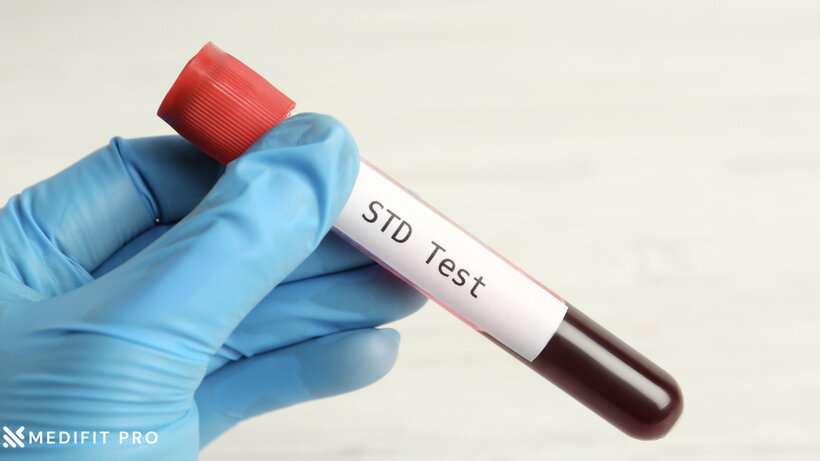We’ve all heard the saying “knowledge is power,” and when it comes to your sexual health, this couldn’t be more true. Sexually transmitted infections (STIs) or sexually transmitted diseases (STDs) are infections that can be passed from one person to another through sexual contact. They can cause a wide range of symptoms, from mild irritation to severe health complications, but the good news is that many STIs are easily treatable with medication. However, the first step to getting treatment is to know if you have an STI, and that’s where things can get a little tricky.
STIs are a common occurrence in sexually active individuals, and anyone who is sexually active can be at risk of contracting an STI, regardless of age, gender, or sexual orientation. Unfortunately, there are many misconceptions about STI’s that can prevent people from seeking testing and treatment.
Some people believe that only those who engage in risky sexual behaviours get STIs, or that STIs always cause obvious symptoms. But, the truth is that many STIs can be asymptomatic or cause mild symptoms that are easily overlooked. In this article, we’ll cover the basics of STIs, including how they are transmitted, what symptoms to look out for, and how to get tested. So, let’s get started and empower ourselves with the knowledge we need to protect our sexual health.
How STIs are Transmitted
STIs are transmitted through sexual contact, which can include vaginal, anal, and oral sex. During this contact, bodily fluids, such as blood, semen, vaginal secretions, and breast milk, can spread the infection from one person to another. It’s important to note that some STI’s can also be transmitted through skin-to-skin contact, even without penetration.
There are many types of STI’s, each with its own mode of transmission. Bacterial infections, like chlamydia, gonorrhea, and syphilis, are spread through contact with infected bodily fluids. Viral infections, such as herpes, HIV, and human papillomavirus (HPV), are also spread through contact with infected bodily fluids, as well as skin-to-skin contact. Parasitic infections, like trichomoniasis and pubic lice, are typically spread through direct contact with the parasite.
Some STI’s can be transmitted even if a person does not have symptoms or is in the early stages of the infection. Additionally, some STI’s can be passed from mother to baby during childbirth or breastfeeding.
Understanding how STI’s are transmitted is essential to prevent their spread and protect sexual health. In the next section, we’ll cover common STI symptoms to be careful about.
Symptoms of STIs
Sexually transmitted infections (STIs) can be challenging to detect, as some may not cause any noticeable symptoms, while others can cause mild to severe symptoms that may be uncomfortable or even painful. Being aware of the various symptoms of STIs is essential to prevent the spread of infections and promote optimal sexual health.
Common symptoms of STIs include genital itching, burning, or discharge. It’s crucial to note that these symptoms can differ depending on the type of STI. For example, chlamydia and gonorrhea can cause painful urination and abnormal vaginal bleeding, while herpes can result in painful blisters or sores on the genital area. Human papillomavirus (HPV) can cause genital warts or abnormal cell changes that can lead to cancer if left untreated.
Please, keep in mind that not everyone with an STI will experience symptoms, particularly for viral infections like HIV and hepatitis B and C. Therefore, regular testing is essential if you are sexually active or have had unprotected sex with a new partner.
If you experience any of these symptoms or have concerns about your sexual health, you must seek medical advice from a healthcare professional or get tested at a clinic. Remember, early detection and treatment of STIs are critical for preventing long-term health complications and protecting yourself and your sexual partners.
Testing for STIs
The only way to confirm whether you have an STI is by getting tested, which is a super important step in managing your sexual health. Many people with STIs may not experience any symptoms or may mistake their symptoms for other medical conditions, making testing pivotal for early detection and treatment.
Several types of tests are available to diagnose STIs, including blood tests, urine tests, and swab tests. Blood tests are used to detect viral infections like HIV and herpes, while urine tests are commonly used to diagnose chlamydia and gonorrhea. Swab tests are typically used to detect STIs in the genital, anal, or oral areas and involve collecting a sample of cells using a swab.
Different STI’s require different tests, and not all STIs can be diagnosed using a single test. Some STIs, like HIV and hepatitis B and C, may not show up on tests immediately after infection. Therefore, you must not forget to get retested after a certain period if you think you may have been exposed to an STI.
Testing can be done at a clinic or through your healthcare provider, and most tests are quick, easy, and confidential. Remember, getting tested for STIs is a part of taking care of your sexual health and preventing the spread of infections to others.
Treatment for STI’s
STI’s can be treated with antibiotics or antiviral medications, depending on the type of STI. While some STI’s, like HIV and herpes, have no cure, their symptoms can be managed with antiviral medications. Antibiotics are commonly used to treat bacterial STI’s like chlamydia, gonorrhea, and syphilis.
It’s really important to complete the full course of treatment, even if symptoms improve or disappear before the end of the treatment. This is because stopping treatment too soon can lead to the development of antibiotic-resistant strains of bacteria, making future infections harder to treat. Additionally, abstaining from sexual contact during treatment is the key to avoid infecting your partner or re-infecting yourself.
You should notify your sexual partners if you test positive for an STI, even if you think you know who gave it to you. By doing so, you can help prevent the spread of infections to others and encourage them to get tested and treated as well.
In some cases, like with HIV and hepatitis B and C, antiviral medications can be used to manage symptoms and slow the progression of the disease. People with chronic STI’s like herpes and HIV may also benefit from ongoing medical care and treatment to manage their symptoms and prevent complications.
Remember, getting tested, diagnosed, and treated for STI’s is of prime importance for breaking the chain of infection spread. If you think you may have an STI or have been exposed to one, don’t wait to seek medical attention.
Prevention of STI’s

STI’s can have serious long-term health consequences, including infertility, cervical cancer, and HIV/AIDS. Thankfully, there are many ways to prevent STI’s and maintain good sexual health.
One of the most effective ways to prevent STIs is to use condoms correctly and consistently during sexual activity. Condoms act as a barrier to prevent the exchange of bodily fluids during sex, which can help to reduce the risk of transmitting or acquiring STIs. But unfortunately, condoms are not 100% effective in preventing all types of STIs, such as herpes or HPV, which can be transmitted through skin-to-skin contact.
Other than using condoms, getting vaccinated against certain STIs, such as HPV and hepatitis B, can also help to prevent infection. The HPV vaccine can protect against several types of HPV that can cause cancer, while the hepatitis B vaccine can prevent infection of the liver.
Reducing the number of sexual partners can also lower the risk of acquiring STIs. The more sexual partners a person has, the higher their risk of coming into contact with an infected person. Therefore, it’s important to be selective about sexual partners and to have open and honest communication about sexual history.
Other ways to prevent STIs include avoiding sexual activity when under the influence of drugs or alcohol, and abstaining from sexual activity until both partners have been tested and confirmed to be STI-free. It’s important to prioritize communication and education about STI prevention and to take steps to protect one’s sexual health.
Summary
In conclusion, STIs are a serious public health concern that affects millions of people worldwide. It’s important to understand the modes of transmission, symptoms, testing options, and treatment options available for STIs. By practicing safe sex and getting tested regularly, we can reduce the spread of STIs and protect ourselves and our partners from potential harm.
Remember that some STIs may not cause any symptoms, so it’s important to get tested regularly, especially if you’re sexually active. Don’t hesitate to talk to your healthcare provider or a trusted medical professional if you have any concerns about STIs.
If you need more information about STIs, testing, or treatment options, there are plenty of resources available. Organizations such as the Centers for Disease Control and Prevention (CDC) and the World Health Organization (WHO) provide comprehensive information on STIs, testing, and treatment. You can also consult with your healthcare provider or a local sexual health clinic for more information.
By staying informed and taking proactive steps to prevent and treat STIs, we can promote healthy sexual practices and reduce the spread of STIs in our communities.
Also read Vaginal Yeast Infections: Prevention and Treatment
Sexually Transmitted Infections (STIs)” by Centers for Disease Control and Prevention: https://www.cdc.gov/std/default.htm
























Recent Comments